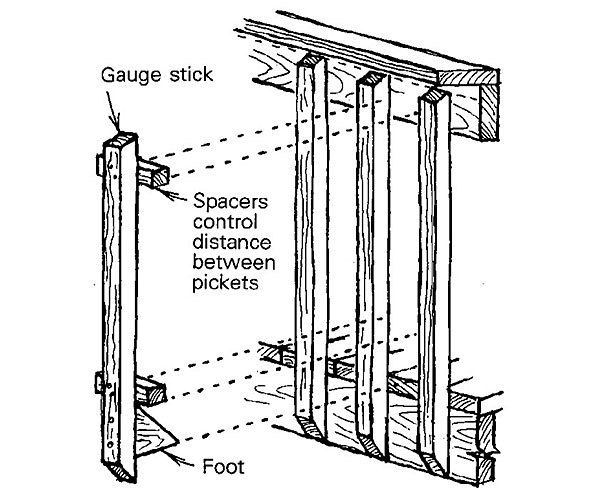
The next time you’re assembling railing pickets on a deck, try using a gauge stick to speed assembly. As shown in the drawing, the gauge stick fits between pickets. Spacers at its top and bottom make it easy to align the next picket, while the gauge stick’s foot rests on the decking.
—Louis J. Fritz, Medford Lakes, NJ
Edited and illustrated by Charles Miller
From Fine Homebuilding #49
Fine Homebuilding Recommended Products
Fine Homebuilding receives a commission for items purchased through links on this site, including Amazon Associates and other affiliate advertising programs.

Angel Guard Deck Demon

4-Gallon Piston Backpack Sprayer

Standard Marking Chalk





























View Comments
The one problem I see with this method is that any variations in the width of the pickets themselves has the potential to throw you off by the time you get to the end of a run, resulting in some pickets not being plumb.
For repetitive spacing I prefer to always pull dimensions from the end and not rely on spacers. Perhaps there's more math involved, but the end result will be more accurate.
This type of railing rarely passes the newest deck codes for impact resistance. Especially without larger newel posts with lateral restraints.
I recommend "Measuring, Marking and Layout" by John Carroll, America's laziest carpenter. He can teach you the easiest (and/or most accurate) way to do almost anything.
In this case, he'd warn about cumulative error- if one of your spacers is 1/16 shorter than the other, after 16 pickets, you'll be out of plumb by an inch. You could compensate for that by turning your gauge end for end each time, but you could still end up 1/2" short overall and if you're trying to maintain 4" baluster spacing your last space in a run could be non-code compliant.
I think Carroll might still recommend using a gauge stick, but checking for cumulative accuracy after a few pickets, then compensating for inaccuracy. Or, he might recommend just stretching a tape, marking each baluster at 5-1/2 (4"+1-1/2") and using a square to make sure the balusters are plumb.
On my phone caluclator, I can enter 5.5, then +, then =, which will give me 11, the second mark. Then each time I hit =, the calculator will give me the next mark, 16.5, 22, 27.5, 33, 38.5, and so on- Ta Da! No Cumulative Error! If you invest in a Construction Master calculator, you can do the same trick with something weird like a 3-19/32 spacing.
I also recommend Carroll's "Working Alone." Most of us have just 2 hands but regularly wish we had 3 or more. Carroll will show you dozens of jigs and tricks that will take the place of that extra hand.
I think a spirit level taped to the picket on the spacer jig would help too. At least it lets you keep track if its still plumb as you build it.
I agree with BobboMax, although your spacer looks good, you're going to find that 2x2's aren't always 1 1/2" x 1 !/2". Some are ! 3/8" and in-between. It's best, more accurate, easier, and you're going to find actually faster if you lay your pickets out like a stud wall with more studs. Once you have your marks, you can zip right thru your layout. A spirit level is never a good idea for anything longer than a foot, use a real level, especially when you're trying to hold something and checking it for plumb...use a real level!
Apropos baluster spacing, check out Mike Guertin's essay on the subject.
https://www.finehomebuilding.com/project-guides/decks/micro-adjust-deck-baluster-spacing-for-eye-deceiving-layout